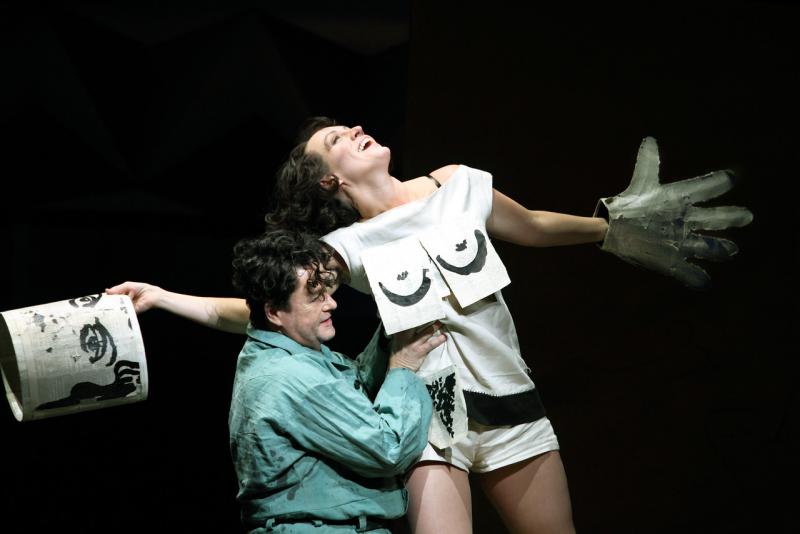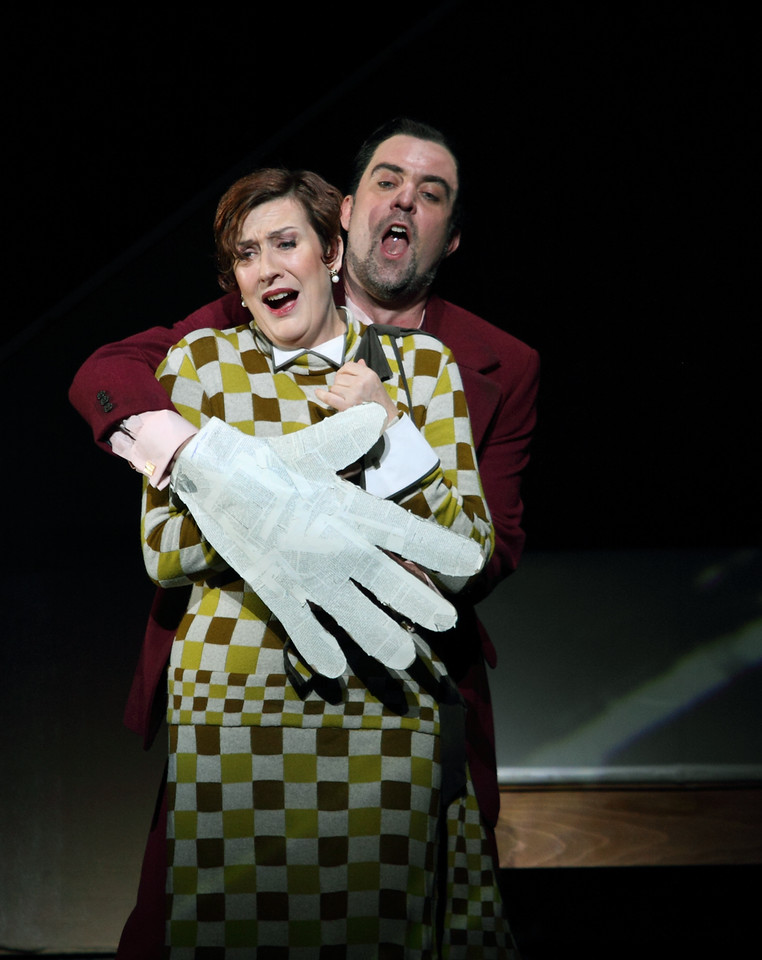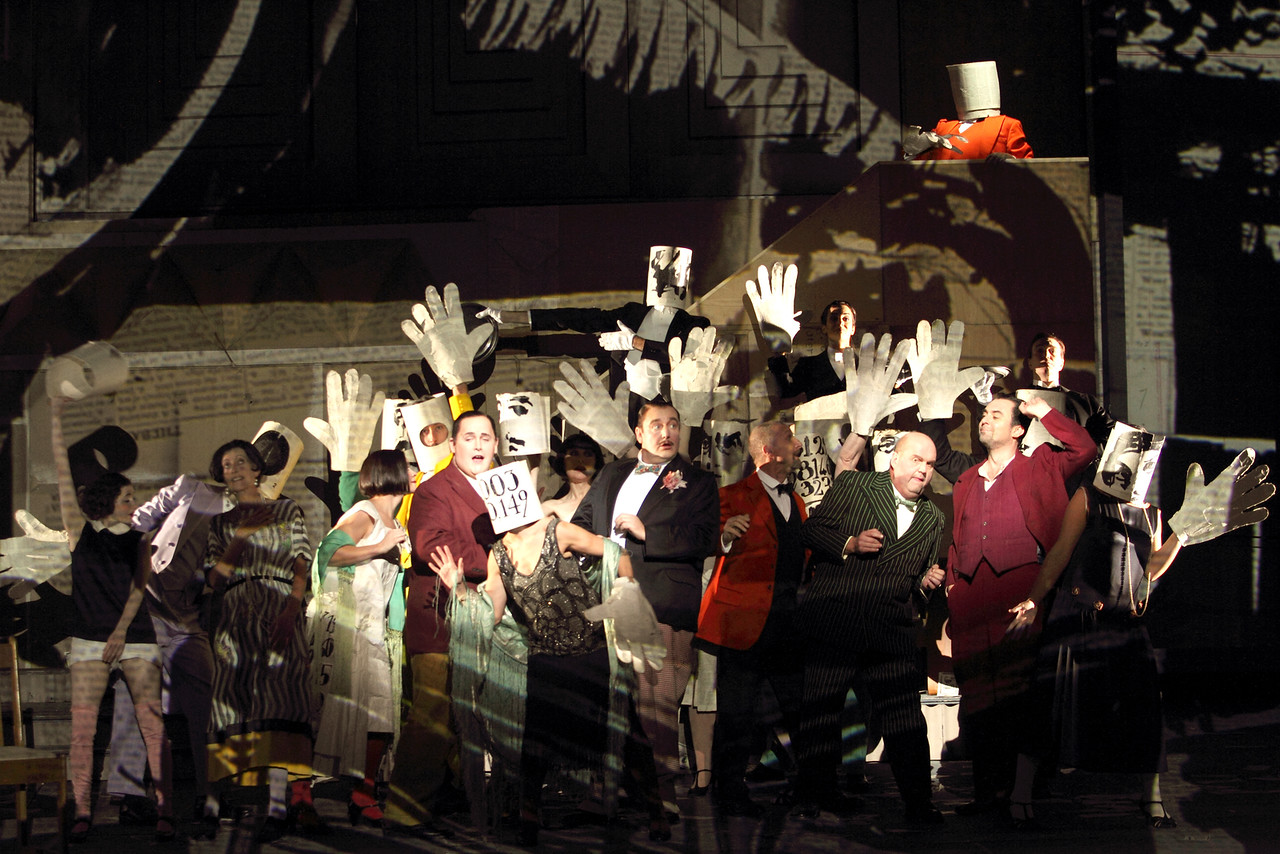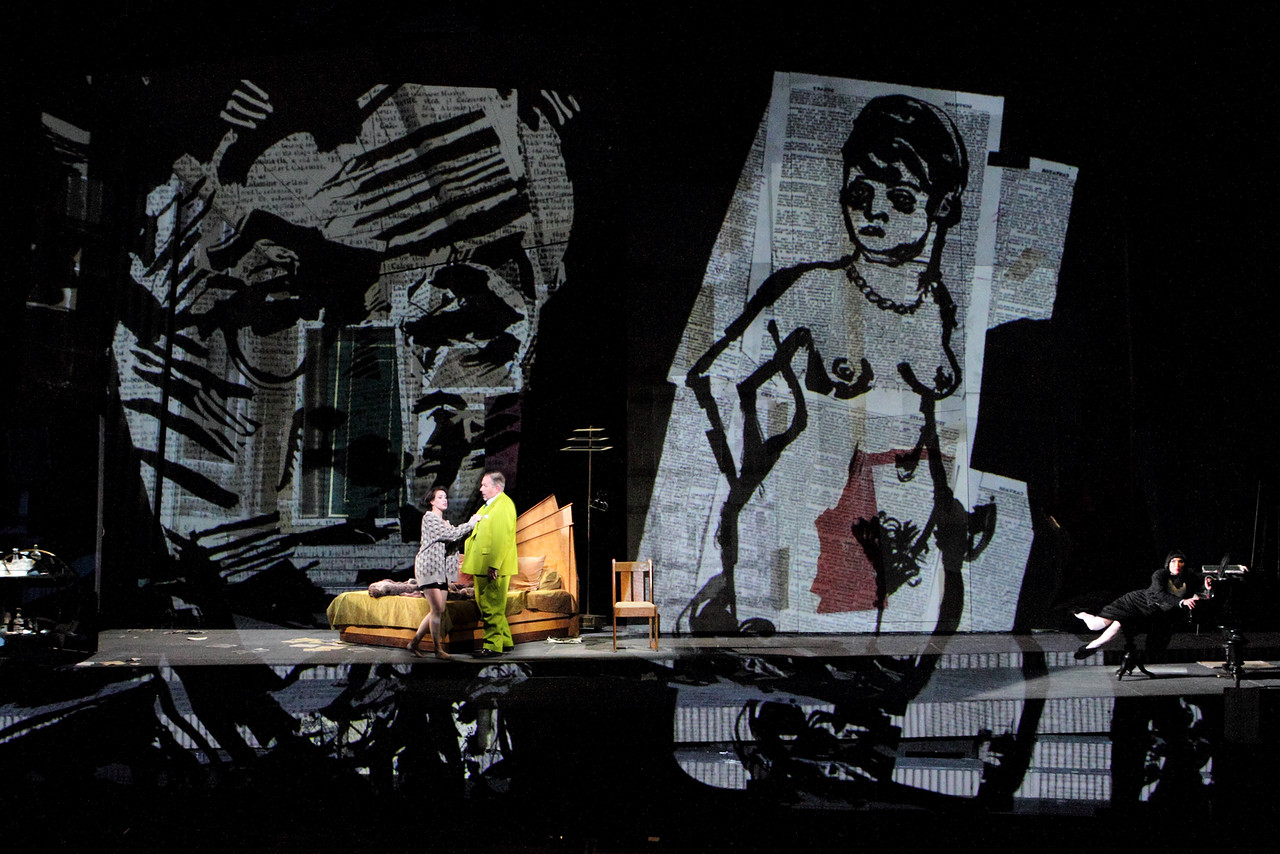Lulu, English National Opera | reviews, news & interviews
Lulu, English National Opera
Lulu, English National Opera
Perfect rapport between stage and pit keeps tabs on William Kentridge's genius

After a day of sheer pain, would it be endless night or cathartic relief at ENO? Both, must be the answer, and much more, all at once.
Has it ever sounded more grounded in its beauty, or more closely connected with the stage shenanigans, than it is here under Mark Wigglesworth, in what is – "tragically" might not be too strong a word – his last opera as ENO Music Director? And could anyone else rivet your attention quite so compellingly given the rival claims of genius artist-director William Kentridge's almost indigestible vision, the only possible supplanter of Richard Jones's unforgettable ENO predecessor (also enriched by Richard Stokes's acrid translation)?
Like Carmen, the operatic Lulu mustn't 'do' sex but be it Throughout Act One, it all seemed as if it might be too much. Compelling from the start is the kaleidoscope of video-projected, sometimes animated black-ink portraits over print, reworkings of German expressionist masterworks which just needed to speak for themselves to remind you that men had the upper hand in studying each other in the 1920s and 30s while women were still just sex-objects. But it could afford to settle for some of the often oblique action, where the comic-grotesque doesn't always have space to breathe, and frankly we don't need anything more during the first two interludes.
In fact I had to stop looking during the initial unfolding of the Mahlerian Adagio which represents the inexorable bond between Lulu and "the only man who ever loved me", Dr Schön. Not difficult to fix attention on the pit since Wigglesworth is in his element here, drawing the kind of deep sound from an ever more magnificent ENO Orchestra which first harrowed us when he came to the Coliseum to conduct Shostakovich's Lady Macbeth of Mtsensk for the first time in 2001.
 The spider-web of sound, though, quite different from Pappano's more lightly sensuous approach for Christof Loy's stripped-down Royal Opera Lulu, is only half the story. What we take for granted is the total music-theatre cohesion between voices and orchestra, which never failed us in the five previous productions Wigglesworth has conducted in his short-lived role. It reaches its apogee here, starting with the crisp delivery of David Soar's Animal-Tamer presenter. He's the first of many ludicrously self-important men in the opera, including the same singer's second role as athlete Rodrigo (pictured right with Sarah Connolly as Countess Geschwitz), a superbly relaxed physical as well as vocal performance.
The spider-web of sound, though, quite different from Pappano's more lightly sensuous approach for Christof Loy's stripped-down Royal Opera Lulu, is only half the story. What we take for granted is the total music-theatre cohesion between voices and orchestra, which never failed us in the five previous productions Wigglesworth has conducted in his short-lived role. It reaches its apogee here, starting with the crisp delivery of David Soar's Animal-Tamer presenter. He's the first of many ludicrously self-important men in the opera, including the same singer's second role as athlete Rodrigo (pictured right with Sarah Connolly as Countess Geschwitz), a superbly relaxed physical as well as vocal performance.
Lulu herself has to be the lynchpin, a killingly demanding high coloratura role. No singers capable of its stratospheric demands are going to have a big voice, and Brenda Rae has to work all her resources to be heard in mid-range in the vast spaces of the Coliseum. But her musicianship and accuracy are just phenomenal, and what's more, she treads the fine line any Lulu must negotiate, but very few do, between knowingness and simply existing as love-object; like Carmen, the operatic Lulu mustn't "do" sex but be it. Not for Rae the implied blankness of the strange child-woman's reactions to the deaths of the men who kill themselves for her. There's an existential despair you really believe in, even if the men on stage don't notice it. And the last-act fall from Parisian society hostess to East End prostitute, where the real tragedy is having to sell what Lulu's always been able to give increasingly on her own terms, is as harrowing as it can be.
By this stage, Kentridge's bewilderingly rich design-concept, potent in its leitmotivic use of painted "heads" and giant hands, is perfectly fused with the interaction of characters (what the Germans call personenregie). Predictably, its apogee has been the rendering of the famous film sequence at the heart of the opera – unfathomably a visual blank in Jones's production – where the music is a perfect palindrome: again there are references to the masterworks of Weimar Germany, in this case recreation of scenes from Pabst's Wedekind-faithful silent film Pandora's Box. But no director just interested in the visuals would be able to order the salon mayhem (pictured below) of the first scene completed by Friedrich Cerha long after Berg's death in 1935 to give the opera the complete symmetry it always cried out for. The company work here of ENO artists as socialites running to the roulette tables and hungry for Jungfrau shares which of course crash horribly operates at the highest level, as always in these last glory days of a company on the verge of Brexit-like self-harm; it's a shame that there are too many good cameos to mention. And from this point on, I think, we buy into the initially distracting Lulu double at the side(s) of the stage who's started out as ordered pianist before mirroring and reacting to the abysmal trajectory of the play-within-a-play's heroine. Whatever you think of this second protagonist, she's mesmerisingly played by actor/dancer Joanna Dudley.
The company work here of ENO artists as socialites running to the roulette tables and hungry for Jungfrau shares which of course crash horribly operates at the highest level, as always in these last glory days of a company on the verge of Brexit-like self-harm; it's a shame that there are too many good cameos to mention. And from this point on, I think, we buy into the initially distracting Lulu double at the side(s) of the stage who's started out as ordered pianist before mirroring and reacting to the abysmal trajectory of the play-within-a-play's heroine. Whatever you think of this second protagonist, she's mesmerisingly played by actor/dancer Joanna Dudley.
Essentially these are the only two figures on stage allowed to develop. The men and the devoted lesbian Countess Geschwitz, lustrously sung as ever by Sarah Connolly in a satisying deconstruction of Coral Browne's character from The Killing of Sister George, all wear the same costumes throughout. The preposterousness and the pretensions of the male perspective are more strongly drawn than usual; even while Nicky Spence stylishly negotiates the cruelly high demands of Berg's seeming alter ego Alwa, Dr Schön's pettish son, you wince at the artistic terms in which he and Michael Colvin's short-lived, self-absorbed Painter see Lulu. As, it finally occurred to me this time round, you're supposed to. Sinister old abusive father-figure Schigolch doesn't have the usual dimension of creepy-comic asthmatic, underlined in the music, but in Willard White's inexorable hands is a powerful manipulator pure and simple. Only James Morris (pictured above with Rae, Dudley to the right), long past his famous Wotan years, is unsympathetically wooden as the unfathomable great love of Lulu's life.
Sinister old abusive father-figure Schigolch doesn't have the usual dimension of creepy-comic asthmatic, underlined in the music, but in Willard White's inexorable hands is a powerful manipulator pure and simple. Only James Morris (pictured above with Rae, Dudley to the right), long past his famous Wotan years, is unsympathetically wooden as the unfathomable great love of Lulu's life.
That undercuts something of the power of the dead Schön's return as Jack the Ripper, but in the resurrection of previous "victims" as "clients" – no disguises here – the clarity of Wigglesworth's outlines leaves us spellbound by the power of musical reminiscence. Maybe that's because I have come to know the score better over the years, but if anyone can help you to grasp it, he can. And this is a show you have to go and see again to begin to gather in all its riches. Don't miss the Kentridge exhibition at the Whitechapel, either.
rating
Share this article
The future of Arts Journalism
You can stop theartsdesk.com closing!
We urgently need financing to survive. Our fundraising drive has thus far raised £49,000 but we need to reach £100,000 or we will be forced to close. Please contribute here: https://gofund.me/c3f6033d
And if you can forward this information to anyone who might assist, we’d be grateful.

Subscribe to theartsdesk.com
Thank you for continuing to read our work on theartsdesk.com. For unlimited access to every article in its entirety, including our archive of more than 15,000 pieces, we're asking for £5 per month or £40 per year. We feel it's a very good deal, and hope you do too.
To take a subscription now simply click here.
And if you're looking for that extra gift for a friend or family member, why not treat them to a theartsdesk.com gift subscription?
more Opera
 The Makropulos Case, Royal Opera - pointless feminist complications
Katie Mitchell sucks the strangeness from Janáček’s clash of legalese and eternal life
The Makropulos Case, Royal Opera - pointless feminist complications
Katie Mitchell sucks the strangeness from Janáček’s clash of legalese and eternal life
 First Person: Kerem Hasan on the transformative experience of conducting Jake Heggie's 'Dead Man Walking'
English National Opera's production of a 21st century milestone has been a tough journey
First Person: Kerem Hasan on the transformative experience of conducting Jake Heggie's 'Dead Man Walking'
English National Opera's production of a 21st century milestone has been a tough journey
 Madama Butterfly, Irish National Opera review - visual and vocal wings, earthbound soul
Celine Byrne sings gorgeously but doesn’t round out a great operatic character study
Madama Butterfly, Irish National Opera review - visual and vocal wings, earthbound soul
Celine Byrne sings gorgeously but doesn’t round out a great operatic character study
 theartsdesk at Wexford Festival Opera 2025 - two strong productions, mostly fine casting, and a star is born
Four operas and an outstanding lunchtime recital in two days
theartsdesk at Wexford Festival Opera 2025 - two strong productions, mostly fine casting, and a star is born
Four operas and an outstanding lunchtime recital in two days
 The Railway Children, Glyndebourne review - right train, wrong station
Talent-loaded Mark-Anthony Turnage opera excursion heads down a mistaken track
The Railway Children, Glyndebourne review - right train, wrong station
Talent-loaded Mark-Anthony Turnage opera excursion heads down a mistaken track
 La bohème, Opera North review - still young at 32
Love and separation, ecstasy and heartbreak, in masterfully updated Puccini
La bohème, Opera North review - still young at 32
Love and separation, ecstasy and heartbreak, in masterfully updated Puccini
 Albert Herring, English National Opera review - a great comedy with depths fully realised
Britten’s delight was never made for the Coliseum, but it works on its first outing there
Albert Herring, English National Opera review - a great comedy with depths fully realised
Britten’s delight was never made for the Coliseum, but it works on its first outing there
 Carmen, English National Opera review - not quite dangerous
Hopes for Niamh O’Sullivan only partly fulfilled, though much good singing throughout
Carmen, English National Opera review - not quite dangerous
Hopes for Niamh O’Sullivan only partly fulfilled, though much good singing throughout
 Giustino, Linbury Theatre review - a stylish account of a slight opera
Gods, mortals and monsters do battle in Handel's charming drama
Giustino, Linbury Theatre review - a stylish account of a slight opera
Gods, mortals and monsters do battle in Handel's charming drama
 Susanna, Opera North review - hybrid staging of a Handel oratorio
Dance and signing complement outstanding singing in a story of virtue rewarded
Susanna, Opera North review - hybrid staging of a Handel oratorio
Dance and signing complement outstanding singing in a story of virtue rewarded
 Ariodante, Opéra Garnier, Paris review - a blast of Baroque beauty
A near-perfect night at the opera
Ariodante, Opéra Garnier, Paris review - a blast of Baroque beauty
A near-perfect night at the opera
 Cinderella/La Cenerentola, English National Opera review - the truth behind the tinsel
Appealing performances cut through hyperactive stagecraft
Cinderella/La Cenerentola, English National Opera review - the truth behind the tinsel
Appealing performances cut through hyperactive stagecraft

Add comment